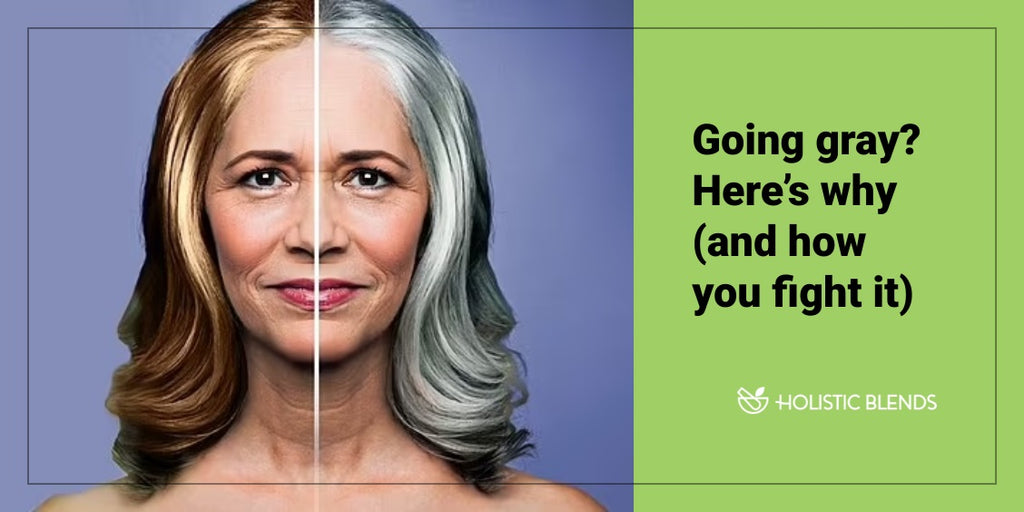I’d like to talk today about what has been considered one of the inevitabilities of life.
Gray hair.
Ah, yes. Few subjects will make a woman cringe as much as the thought of going gray, and the hair color industry is very happy that you feel that way.
Of course, men go gray too, but it’s long been said that gray hair makes a man look distinguished and a woman look old.
I’ll let you ponder that, but over the last decade or so, evidence has come about that challenges the contention that, “We all must face the gray someday” and looks into what is behind our hair starting to resemble salt and pepper.
Let’s start by looking deeply into the happenings of your hair…
What’s your hair up to?
Human hair actually has three cycles—a growth phase (anagen), a resting phase (catagen) and a dormant phase (telogen). The hair follicles produce pigment (color) during the anagen phase while hair is growing.
During the anagen (growth) phase, the hair grows about half an inch in length every 28 days. While the amount of time the follicle remains in the anagen phase differs from person to person (it is determined genetically and to a lesser degree hormonally), this phase typically lasts from two to six years.
The catagen phase is a short transitional phase that lasts about two weeks. During catagen the follicle begins to shrink, and the individual hair becomes restricted from nourishment (blood supply) provided by the underlying vessel. Then telogen sets in.
The telogen phase is a resting phase which lasts around three months. During this phase the hair is released from the follicle, falls out, and a new hair begins to grow in its place (i.e. anagen is restarted).
Most healthy scalps will shed 50 to 150 stands of hair each day! So, it’s not necessarily a bad thing to see hair in your shower drain.
The arrival of gray
Most people don’t realize this, but every hair on your head actually starts off as white! But then the hair is colored in the anagen (growth) phase by a natural pigment called melanin.
As your hair grows, melanocytes — the cells that produce melanin — transfer the melanin to each individual hair follicle, which perfectly colors every strand of hair.
Nature is the perfect salon colorist…at least for a while.
As time goes on and we age, melanocyte activity slows down and eventually stops, leading to less pigment in the hair.
Although everyone is different, the fact remains that your chances of going gray increase 10 to 20 percent every decade after the age of 30.
Is it hopeless?
While it seems that Nature has set plans for salt and pepper hair in most of our futures, there are some factors that speed up the process…and if you address those factors, you can help SLOW the arrival of gray hair.
These factors include:
Thyroid conditions: Thyroid disease could trigger the development of gray hair.
How to help: If you suspect thyroid problems, see your doctor and ask him/her to explore bio-identical hormone replacement therapy (such as Armour Thyroid) if necessary.
Autoimmune conditions: Autoimmunity occurs when your immune system becomes hypersensitive and launches an inflammatory attack against your healthy cells, tissues and organs. When the autoimmune process targets hair follicles, you can go gray as a result.
How to help: There is no cure for autoimmunity, but getting enough vitamin D (as in our Optimum DK Formula) can help tame the inflammatory actions of your immune system.
Nutrient deficiencies: Your hair follicles have vitamin D in them, so being low can affect your hair’s pigmentation. In addition, vitamin B12 is crucial for ALL your cells to function properly, including your melanocytes.
How to help: Vitamins D and B12 are two of the most common vitamin deficiencies, especially in the northeast. Consider supplementing with Optimum DK Formula and Hydroxaden Vitamin B formula to ensure your body has health-supporting levels of these crucial vitamins.
Stress: Research has shown that stress can cause hair to gray prematurely by affecting the stem cells that are responsible for regenerating hair pigment.
How to help: Do whatever it takes to help reduce stress in your life. Stress affects your body from head to toe, and you can now add your hair graying onto the long list of health concerns triggered by stress.
Smoking: There is a link between premature aging (as well as premature graying) and smoking due to the effects of smoking on your hair follicles.
How to help: This is yet another reason to quit if you are a smoker. Get help if you need it.
Your diet: Hydrogen peroxide is a natural by-product of our metabolism, but it can also contribute to the breakdown of pigments in your hair. Catalase, an antioxidant enzyme found in our diets in plant and animal cells, breaks down excess hydrogen peroxide.
However, as we age, our bodies produce less catalase, which can cause hydrogen peroxide to build up in the hair follicles…thereby “bleaching” your hair follicles from the inside out!
How to help: Incorporate sources of catalase into your diet, including garlic, onions, cauliflower, potatoes, broccoli, kale and cabbage.
Also, the mineral zinc has been shown to play an important role in the production of new hair and skin cells, which helps hair gain thickness and intensify its color. Food sources of zinc include shrimp, dark meat poultry, liver, eggs, legumes (including peanuts), fish and whole grains.
To your health,
Sherry Brescia











